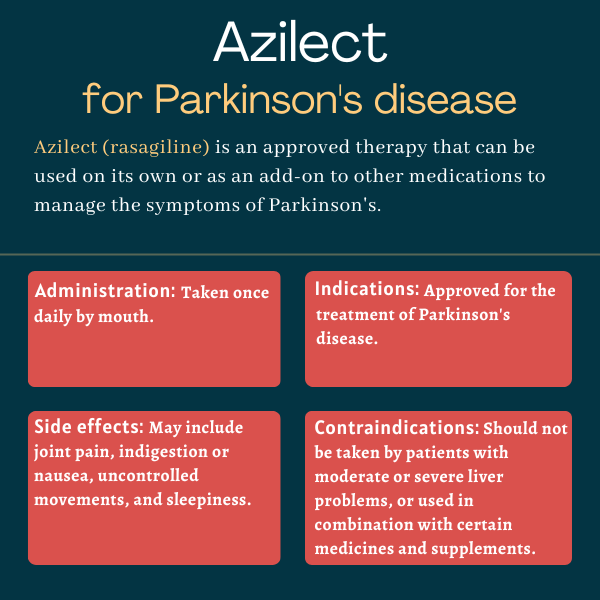Azilect (rasagiline) for Parkinson’s disease
What is Azilect for Parkinson’s disease?
Azilect (rasagiline) is an oral therapy that can be used on its own or in combination with other medicines to ease the symptoms of Parkinson’s disease. It is sold by Teva Pharmaceuticals.
Generic equivalents to Azilect also also available.
Therapy snapshot
| Brand name: | Azilect |
| Chemical name: | rasagiline |
| Usage: | Used on its own or in combination with other medicines to ease the symptoms of Parkinson’s |
| Administration: | Once daily oral tablets |
How Azilect works
In Parkinson’s disease, nerve cells in the brain that produce dopamine — a chemical messenger that sends signals between brain cells — gradually sicken and die. Dopamine signaling is essential for coordinating movement, and decreasing levels lead to Parkinson’s symptoms.
Azilect is a monoamine oxidase-B (MAO-B) inhibitor that acts to increase the levels of dopamine in the brain. MAO-B is an enzyme that normally breaks down dopamine, acting to prevent its levels from getting too high. By stopping this enzyme from working, Azilect can help the brain maintain for a longer time a small amount of dopamine, restoring some degree of dopamine communication and easing disease symptoms.
Azilect frequently is prescribed alongside levodopa and its derivatives. Levodopa is a chemical that is converted into dopamine in the brain. Since Azilect prevents dopamine from being broken down, it can extend the time the levodopa therapy is active. This can decrease off time, where patients experience problematic symptoms in between scheduled doses of levodopa.
Who can take Azilect?
Azilect was approved by the U.S. Food and Drug Administration (FDA) in 2006. It is indicated for the treatment of Parkinson’s disease, either on its own or in combination with other medicines.
It is also approved in many other countries, including Canada and the European Union.
Who should not take Azilect?
Azilect should not be taken in combination with any of the following medications and supplements:
- meperidine (a pain medication)
- tramadol (a pain medication)
- methadone (a pain medication)
- propoxyphene (a pain medication)
- dextromethorphan (a cough medicine)
- St. John’s wort (a plant used for conditions such as depression, attention-deficit hyperactivity disorder or obsessive-compulsive disorder)
- cyclobenzaprine (a muscle relaxer)
- any other monoamine oxidase inhibitor.
Azilect should not be used in patients with moderate or severe liver problems.
How is Azilect administered in Parkinson’s?
Azilect is available in oral tablets at dosage strengths of 0.5 mg and 1 mg. These are round and flat tablets, white to off-white in color. One side has the dosage imprinted, either “GIL 0.5” or “GIL 1,” and the other side is plain.
For patients who are not taking levodopa, the recommended starting dose is 1 mg per day.
For patients on levodopa, either with or without other Parkinson’s medicines, the recommended starting dose is 0.5 mg per day. If this dose is well tolerated but does not sufficiently control symptoms, the dosage may be increased to 1 mg per day. It also may be possible to reduce levodopa doses when Azilect is added, depending on how the individual responds to treatment.
The recommended doses should not be exceeded due to the risk of increased blood pressure (hypertension).
In patients taking the antibiotic ciprofloxacin or other medications that block the liver enzyme CYP1A2, doses of Azilect should not exceed 0.5 mg per day.
In patients with mild hepatic (liver) impairment, the dose of 0.5 mg per day should not be exceeded.

Azilect in clinical trials
The FDA’s approval of Azilect was supported by data from four clinical trials. One study tested Azilect as monotherapy (that is, without other Parkinson’s medicines), while the other three tested Azilect as an adjunct or add-on to levodopa or other Parkinson’s treatments.
Monotherapy study
A Phase 3 clinical trial (NCT00203060) tested Azilect as a monotherapy in 404 patients who had been living with Parkinson’s for an average of about one year. Participants were randomly assigned to take Azilect at 1 or 2 mg each day, or a placebo, for about six months.
The study’s main goal was to test Azilect’s effectiveness using the Unified Parkinson’s Disease Rating Scale (UPDRS), a standardized measure that assesses the severity of symptoms and how much they interfere with day-to-day life. After six months, a worsening in the average UPDRS score of nearly four points was seen in patients given placebo. In contrast, patients treated with Azilect had an average score worsening of less than one point at six months. Results were comparable for the two doses of Azilect.
Add-on trials
A Phase 4 clinical trial (NCT01049984), called ANDANTE, tested Azilect as an add-on in patients with early disease who had been on a stable dose of a dopamine agonist — specifically ropinirole or Mirapex (pramipexole) — that was not sufficient for controlling their symptoms. This study enrolled 321 patients with an average disease duration of about two years.
Patients received either a placebo or Azilect at 1 mg per day. The trial’s main goal was the effect of Azilect on UPDRS scores after 18 weeks of treatment.
Results showed that, with almost five months of treatment, the average UPDRS score improved by 3.6 points in patients given Azilect, compared with 1.2 points in the placebo group. Its beneficial effects primarily were due to improvements in motor function.
The other two trials tested Azilect as an add-on to levodopa in patients who were experiencing considerable off time, periods where symptoms aren’t controlled between levodopa doses. One study (NCT00203034) was conducted in the U.S. and Canada, the other in Europe, Israel, and Argentina. Collectively, the trials enrolled more than 1,000 patients who had been living with Parkinson’s for an average of nine years and had been on levodopa for an average of eight years.
At the start of both studies, participants were experiencing an average of about 5.5 to 6 hours of off time each day. A main goal was to assess how Azilect treatment affected off time. In both studies, the amount of daily off time decreased by less than one hour for patients given placebo. For those given Azilect at doses of 1 or 0.5 mg/day, average daily off time decreased by more than an hour. UPDRS scores, overall, also favored Azilect over a placebo.
Common side effects of Azilect
When Azilect is used on its own, the most commonly reported side effects are:
- flu-like symptoms
- joint pain (arthralgia)
- depression
- indigestion (dyspepsia).
When Azilect is used in combination with levodopa, common side effects include:
- uncontrolled movements (dyskinesia)
- falls and accidental injuries
- weight loss
- low blood pressure upon standing (postural hypotension)
- nausea and vomiting
- loss of appetite
- joint pain
- abdominal pain
- constipation
- dry mouth
- rash
- abnormal dreams
- inflammation around tendons (tenosynovitis).
When Azilect is used in combination with treatments other than levodopa, common side effects are:
- swelling
- falls
- joint pain
- cough
- insomnia.
Blood pressure problems
Azilect can cause or worsen high blood pressure (hypertension), which may require treatment to be adjusted or stopped.
A compound called tyramine, which is present in some foods like aged cheeses, processes meats, and beer, may worsen high blood pressure related to Azilect. It’s generally not required for patients taking approved doses of Azilect to restrict the amount of tyramine in their diet, although some patients may be advised to avoid certain high-tyramine foods.
Azilect also can cause low blood pressure (hypotension), particularly orthostatic hypotension, in which blood pressure drops when a person moves to stand from a seated or laying position. This side effect occurs most frequently in the first months after starting the treatment and tends to ease over time.
Serotonin syndrome
Azilect should not be used in combination with antidepressants, because this can result in a potentially fatal reaction known as serotonin syndrome. Symptoms of serotonin syndrome can include dramatic changes in behavior and thought patterns; muscle changes like tremor, twitching or rigidity; and changes with subconscious body processes like sweating and heart rate.
Sleepiness
Azilect can cause sleepiness, and cause some patients to fall asleep during daily activities, including while driving motor vehicles. If patients experience sleepiness or drowsiness that substantially affects daily life, Azilect usually should be discontinued. If the decision is made to continue the medication, then patients with episodes of falling asleep unexpectedly should avoid potentially dangerous situations, including driving.
Dyskinesia
When used in combination with levodopa, Azilect can cause or worsen dyskinesia. Lowering the dose of levodopa may help ease this side effect.
Mental and behavioral problems
Azilect can cause changes in thinking and behavior, which may include paranoid thoughts, confusion, agitation, aggression, delirium, fixed beliefs that aren’t based in observable reality (delusions), and hearing or seeing things that aren’t there (hallucinations). If these issues develop, the dose of Azilect may be reduced or treatment may be stopped.
Some patients given Azilect may experience intense urges to engage in risky behaviors such as gambling, spending money, binge eating, or sexual behaviors. These urges sometimes stop when treatment is stopped or the dose is lowered, but sometimes they do not. Since patients themselves may not register these impulses as abnormal, it’s important for clinicians to explicitly ask patients and their caregivers about such issues.
Withdrawal
Suddenly stopping Azilect may cause withdrawal symptoms characterized by increased body temperature, muscle rigidity, changes in consciousness, and changes in automatic body functions.
Liver problems
Azilect should not be used in patients with moderate or severe liver problems, as it can lead to increased levels of its active compound in the bloodstream.
Melanoma
Studies have shown that people with Parkinson’s are at increased of the skin cancer melanoma, but to date it remains unclear whether this is because of Parkinson’s itself, or because of Parkinson’s treatments like Azilect. Either way, people with Parkinson’s should have regular skin examinations to monitor for melanoma.
Use in pregnancy and breastfeeding
There are no adequate studies of Azilect in people who are pregnant or breastfeeding. The medication should only be used in these situations if, in consultation with a doctor, the potential benefit justifies the risk.
Parkinson’s News Today is strictly a news and information website about the disease. It does not provide medical advice, diagnosis, or treatment. This content is not intended to be a substitute for professional medical advice, diagnosis, or treatment. Always seek the advice of your physician or another qualified health provider with any questions you may have regarding a medical condition. Never disregard professional medical advice or delay in seeking it because of something you have read on this website.
Recent Posts
- Pandemic stress associated with higher inflammation in Parkinson’s
- Companies team on bringing Parkinson’s treatments to brain
- Dosing begins in clinical trial of Parkinson’s cell therapy RNDP-001
- MJFF awards grants to advance 5 new targets for Parkinson’s drugs
- Experimental vaccine shows early signs of benefit in Parkinson’s
Related articles

 Fact-checked by
Fact-checked by 




